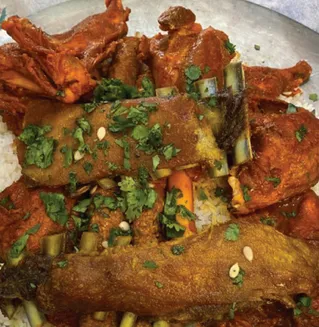Kashmiri cuisine is a delightful fusion of vibrant flavors and aromatic spices, offering an experience that reflects the region’s rich cultural diversity. Infused with locally sourced ingredients such as saffron, fennel, and ginger, along with the distinctive essence of cardamom, Kashmiri dishes boast a unique and characteristic taste. This cuisine caters to a broad spectrum of preferences, making it equally appealing to both meat enthusiasts and vegetarians. Although the fact is that it is slightly more biased towards the meat enthusiasts but one gets the point.
The wide range of flavors and textures in Kashmiri cuisine ensures a delightful experience for the one enjoying the food, me in this case.
The Culinary Extravaganza of Wazwan:
At the heart of Kashmiri cuisine lies Wazwan, a culmination of various savory and sumptuous dishes which were, in a traditional sense, passed down through generations. Wazwan, a multi-course meal, stands as a testament to Kashmiri cooking techniques. This meal is a must-experience for those seeking an authentic taste of Kashmiri traditional cuisine. In Kashmiri, ‘waz’ translates to ‘cook’ or ‘cooking,’ and ‘wan’ means ‘shop’. As deservedly extravagant as wazwan is, it is no surprise that at the pinnacle of formal banquets in Kashmir serving Wazwan has become an obligatory practice. Without it a wedding can’t be imagined. This royal feast comprises thirty-six courses, with a majority showcasing meticulously prepared meat dishes. A “wastei waze” i.e. a master chef, oversees the overnight cooking process.
Guests, arranged in groups of four, seated in long columns partake in the meal from a single large copper plate (coated with zinc) known as the ‘traem.’ The feast commences with a ceremonial hand washing using a portable basin called ‘Tash-t-naer,’ followed by the arrival of the traem initially laden with rice, seekh kababs, methi maaz, tabakh maaz, safed kokur, and zafran kokur, among other delicacies.
The tasteful journey unfolds with yogurt and chutney served separately in small earthen pots. The Waza, a junior cook, then presents up to a whopping 20 additional dishes turn after turn. Some may consider this excessive and wasteful especially from a religious perspective but the practice seems to be undeterred.
In most cuisines, there are some staple dishes that can’t be left out. Eight such dishes (if cooked properly) in Wazwan hold that same essentiality namely Kababs, Tabakh maaz, Rista, Rogan josh, Daniwal korma, Aab gosh (a people favourite), marcze-wangan korma, and gushtaba— a substantial meatball that signifies the conclusion of the main course. The dessert phase follows, featuring warm sweets in winter and refreshing options in summer.
Rogan Josh:
Rogan Josh, by definition, may mean “stewed in ghee”. In the hearts of Kashmiri people or stomachs if one wishes to be precise over being poetic, Rogan Josh takes the spotlight—a master blend of succulent mutton, aromatic spices, sautéed onions, tomatoes and a crescendo of flavors. And the grand finale features a vibrant infusion of Kashmiri red chili powder, sizzling oil or ghee. Garnished with fresh coriander.
Tabakh Maaz:
Tabakh Maaz, a gem of a dish that showcases the region’s rich heritage. This dish transforms lamb ribs into a delicacy through a diligent cooking process. First braised with a blend of fragrant spices, the ribs are then fried to perfection. The result is a heavenly marriage of tenderness and crispiness. Served as part of the royal Wazwan feast, Tabakh Maaz is a testimony to Kashmir’s cooking prowess—a dish that oozes tradition with every bite.
Rista:
Rista is a celebration of meat in the form of delicate, flavorful meatballs. Each meatball is carefully prepared and bathed in a luxurious gravy infused with the vibrant hues of paprika, saffron, and fennel. The vivid taste and pleasant flavors of Rista tell the story of tradition, skill, artistry and thus, the essence of Kashmiri cuisine.
As Wazwan is served, each Traem (plate) receives four Ristas, and it is the first delicacy served by the Waza, adding a touch of ceremony to this exquisite experience.
Importance of Local Produce in Kashmiri Cuisine:
In the mosaic of Kashmiri cuisine, apples, walnuts, and saffron stand as iconic symbols, contributing not only to the flavors but also to the cultural and economic complex of the region. The renowned Kashmiri Apples, lend their sweet and crisp profile to various dishes. They find their way into desserts, chutneys, and even savory preparations, adding a natural sweetness and refreshing crunch. Orchards of apple trees adorn the Kashmir Valley, making apples not just a delight with respect to food but also a symbol of the region’s picturesque landscape. The annual apple harvest is a much celebrated event as a lot of families depend on it, reflecting the cultural and economic importance of this fruit.
Walnuts are a versatile ingredient in Kashmiri cuisine, finding a place in both sweet and savory dishes. They add a rich, nutty flavor and a satisfying crunch to various delicacies like Kashmiri ‘Gouji Chutney’, Kashmiri Pulaaw, and Tabakh Maaz. From traditional desserts to spicy meat preparations, walnuts are a culinary cornerstone. Walnut trees are a common sight in the region.
Saffron, often referred to as “Zafran” in Kashmiri, is a precious spice that imparts a distinctive golden hue and a subtle floral flavour to dishes. It is a key ingredient in the aromatic Kashmiri Wazwan and the famous Kashmiri Kahwa along with various desserts. Kashmiri saffron is globally renowned for its quality. The cultivation of saffron has historical roots in the region, and the spice holds cultural significance, being associated with traditional rituals and ceremonies. The place in Kashmir named ‘Pampore Wuddar’ is the most famous and top producer of Saffron in Kashmir.







